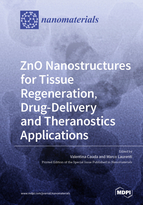ZnO Nanostructures for Tissue Regeneration, Drug-Delivery and Theranostics Applications
A special issue of Nanomaterials (ISSN 2079-4991).
Deadline for manuscript submissions: closed (1 January 2019) | Viewed by 35730
Special Issue Editors
Interests: nanomedicine; nanotechnology; extracellular vesicles; zinc oxide; acoustic cavitation; ultrasound-assisted therapies; drug delivery
Special Issues, Collections and Topics in MDPI journals
Interests: thin films growth and characterization; metal oxides; graphene and related materials; piezoelectric and semiconductor materials; thin-film catalysts; antibacterial coatings; smart materials for tissue engineering
Special Issues, Collections and Topics in MDPI journals
Special Issue Information
Dear Colleagues,
Zinc oxide nanostructures are capturing a great deal of interest thanks to their outstanding and multifunctional properties, coupled with the existence of a huge amount of nano-morphologies (such as nanowires, nanorods, nanoparticles, and nanoflowers), as well as their easy preparation. These aspects fostered a deep investigation of ZnO nanomaterials and related properties, to design and fabricate smart biocompatible nanotools, which have been successfully applied to a wide plethora of applications, ranging from energy harvesting systems and photocatalysis, to the biomedical field. In such particular case, ZnO nanostructures alone or combined into hybrid or composite systems represented a powerful tool for the fabrication of new scaffolds for tissue regeneration with improved antimicrobial properties, as well as for drug-delivery applications. Moreover, the promising optical and biocompatible properties of ZnO have been successfully combined together, resulting into the co-presence of imaging and therapeutic actions. This aims at designing novel nanosystems for theranostic applications in particular for cancer therapy.
This Special Issue of Nanomaterials is dedicated to the most recent advances in the use of ZnO nanostructures for designing novel “smart” biomedical systems applied to tissue engineering, drug-delivery and theranostics. Participation with research papers and reviews, focused on these topics and ranging from the synthesis and characterization of the raw materials, up to their final in-vitro and in-vivo applications, is highly encouraged.
Prof. Dr. Valentina Cauda
Dr. Marco Laurenti
Guest Editors
Manuscript Submission Information
Manuscripts should be submitted online at www.mdpi.com by registering and logging in to this website. Once you are registered, click here to go to the submission form. Manuscripts can be submitted until the deadline. All submissions that pass pre-check are peer-reviewed. Accepted papers will be published continuously in the journal (as soon as accepted) and will be listed together on the special issue website. Research articles, review articles as well as short communications are invited. For planned papers, a title and short abstract (about 100 words) can be sent to the Editorial Office for announcement on this website.
Submitted manuscripts should not have been published previously, nor be under consideration for publication elsewhere (except conference proceedings papers). All manuscripts are thoroughly refereed through a single-blind peer-review process. A guide for authors and other relevant information for submission of manuscripts is available on the Instructions for Authors page. Nanomaterials is an international peer-reviewed open access semimonthly journal published by MDPI.
Please visit the Instructions for Authors page before submitting a manuscript. The Article Processing Charge (APC) for publication in this open access journal is 2900 CHF (Swiss Francs). Submitted papers should be well formatted and use good English. Authors may use MDPI's English editing service prior to publication or during author revisions.
Keywords
-
zinc oxide
-
nanostructures
-
tissue engineering
-
antibacterial properties
-
theranostics
-
drug-delivery







